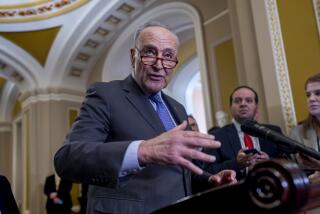Administration Backs Accord on S&L; Bailout
- Share via
WASHINGTON — The massive federal bailout of the savings and loan industry foundered Thursday night as the Senate rejected the House-approved procedure for financing the rescue plan, but House and Senate negotiators quickly patched together a new compromise that they hope will win congressional approval today.
The Bush Administration, which had threatened to veto the earlier version of the bill, endorsed the new plan. “In the spirit of compromise, we accept,” Treasury Secretary Nicholas F. Brady told congressional negotiators.
But House negotiators remained deeply divided over the new compromise and final House approval in today’s vote appears to be less than a forgone conclusion.
Dispute Over Financing
The rescue plan stalled when the House and Senate could not agree on how to manage the cost of selling $50-billion worth of bonds to finance it.
The House had voted to add the $50 billion directly to the federal deficits for this year and the next two. That would bust the deficit ceilings imposed by the Gramm-Rudman balanced-budget law for 1990 and 1991 and the House-passed bill would exempt the $50 billion from Gramm-Rudman.
The Senate, however, refused to provide an exemption from Gramm-Rudman. Senators voted, 54 to 46, in favor of an exemption but the Gramm-Rudman law requires the votes of 60 senators before such an exemption can be approved.
That sent congressional negotiators back to work. Senate Banking, Housing and Urban Affairs Committee Chairman Donald W. Riegle Jr. (D-Mich.) proposed a compromise: The first $20 billion in bonds, to be sold before fiscal 1989 ends on Sept. 30, would be counted as part of the deficit; but the next $30 billion, to be sold in equal installments in 1990 and 1991, would not.
House Ways and Means Committee Chairman Dan Rostenkowski (D-Ill.), insisting that the full $50 billion should be counted as part of the deficit, called Riegle’s offer “an unacceptable compromise.”
Ways and Means Committee member J. J. Pickle (D-Tex.) added: “Why do you assume we came here to compromise? . . . . What we should do is put it on the budget and raise the taxes to pay for it.”
The House negotiators ultimately supported the Riegle plan by a narrow vote of 26 to 22. The five Senate negotiators voted, 4 to 1, for the plan.
The close vote among the House negotiators suggested that when the bill goes back to the House floor today, it will have to pick up Republican support to compensate for the Democrats who might follow Rostenkowski and oppose it.
That support appeared in sight. Rep. Steve Bartlett (R-Tex.) predicted that of the 132 Republicans who voted against the bill that reached the House floor earlier Thursday, 60 to 90 would support the new version if the Administration would back it, as it later did.
The Riegle compromise neatly finessed the obstacle of the Gramm-Rudman law. The $20-billion increase in the deficit in 1989 would escape the strictures of Gramm-Rudman, which no longer applies to the current fiscal year. For 1990 and 1991, when Gramm-Rudman still applies, the $30 billion in bond sales would not be counted toward the deficit.
Barely Clears House
The earlier version of the bill, with its exemption from the Gramm-Rudman law, narrowly cleared the House even though President Bush promised to veto it in that form.
Then the bill stalled on the Senate floor when Sen. Phil Gramm (R-Tex.) led the effort to block the exemption from the deficit-reduction law that bears his name. Gramm said that an exemption, as already approved narrowly by the House, would “destroy budget discipline.”
He and other Republicans argued that the S&L; bailout should be financed separately from the federal budget, through $50 billion in federally guaranteed bonds issued by a new agency called the Resolution Trust Corp. That way, only the repayments on the bonds would show up on government books as annual outlays.
Most Democrats held firm for financing the bailout with $50 billion in Treasury Department bonds. That approach would save the taxpayers several billion dollars in interest costs over the 30-year life of the bonds, the Democrats insisted, because Treasury bonds typically carry lower interest rates than those that merely carry federal guarantees.
Congress felt under considerable pressure to resolve the dispute before adjourning today for a scheduled 40-day recess. Every day’s delay in enacting a bill costs taxpayers an estimated $10 million as insolvent but still operating thrift institutions lose more money.
The dispute over how to finance the bailout obscured a general agreement over the terms of what would be the largest federal bailout ever.
Under the legislation as approved by the House, the government would use the $50 billion to shut down bankrupt S&Ls; and make good on federal deposit insurance, which covers each depositor’s assets up to $100,000.
The ultimate cost of paying the principal and interest on the $50 billion worth of bonds could reach up to $300 billion. The White House has estimated the cost over the next 10 years alone at $166 billion.
Taxpayers would pay about three-quarters of the cost. Banks and solvent S&Ls; would pay the rest through higher deposit insurance fees.
The bill also would require S&Ls; to maintain at least 3% of their assets as capital available to pay depositors. It would increase civil penalties for S&L; and bank fraud, direct thrift institutions to devote more attention to the financing of home mortgages and set aside funds to help pay for housing for low- and moderate-income persons.
Although the bill gave Bush most of what he asked for when he proposed the S&L; bailout in February, he said in a letter to congressional leaders Thursday that he opposes both the subsidies for low-cost housing and the exemption from the Gramm-Rudman law.
Bush had added an offer to negotiate a compromise. “It is essential to resolve the dispute this week . . . “ he said. “Working together in a bipartisan spirit, we can achieve a fully responsible result.”
In the Senate, the vote to deny an exemption from the Gramm-Rudman law was almost entirely along party lines.
Among the 45 Republicans, only Larry Pressler of South Dakota failed to support Bush’s opposition to the waiver. The 44 other Republicans were joined by two of the 55 Democrats, Alan J. Dixon of Illinois and Kent Conrad of North Dakota.
A procession of Democratic senators, including Ernest F. Hollings of South Carolina and Howard M. Metzenbaum of Ohio, denounced as “baloney” the strategy of Republicans to move the $50-billion bond sale off the federal budget.
Republicans countered that their approach is preferable to voting an exemption of the Gramm-Rudman law, which they credited with having cut sharply into the federal deficit without need of higher taxes.
In the House, 67 Democrats, many of them unhappy with tough new capital requirements for the thrift industry, voted against the bill on final passage.
At the same time, 40 Republicans, including Chalmers P. Wylie of Ohio, the ranking Republican on the Banking, Finance and Urban Affairs Committee, supported the bill even while agreeing with Bush’s opposition to counting $50 billion of the cost in the budgets for the next three fiscal years.
The deficit issue was crucial. The President, said Rep. Charles E. Schumer (D-N.Y.), wants taxpayers “to spend billions more so he can hide his deficit off the budget . . . . We are not going to back off in this House.”
Republicans, by contrast, noted with approval that Bush’s proposal would require the thrift industry to buy the bonds that would raise the $50 billion needed to bail out failing institutions.
“Under the Administration’s financing proposal, the funding is the obligation of the industry, not of the government,” Rep. Bill Frenzel (R-Minn.) said.
More to Read
Get the L.A. Times Politics newsletter
Deeply reported insights into legislation, politics and policy from Sacramento, Washington and beyond. In your inbox three times per week.
You may occasionally receive promotional content from the Los Angeles Times.










